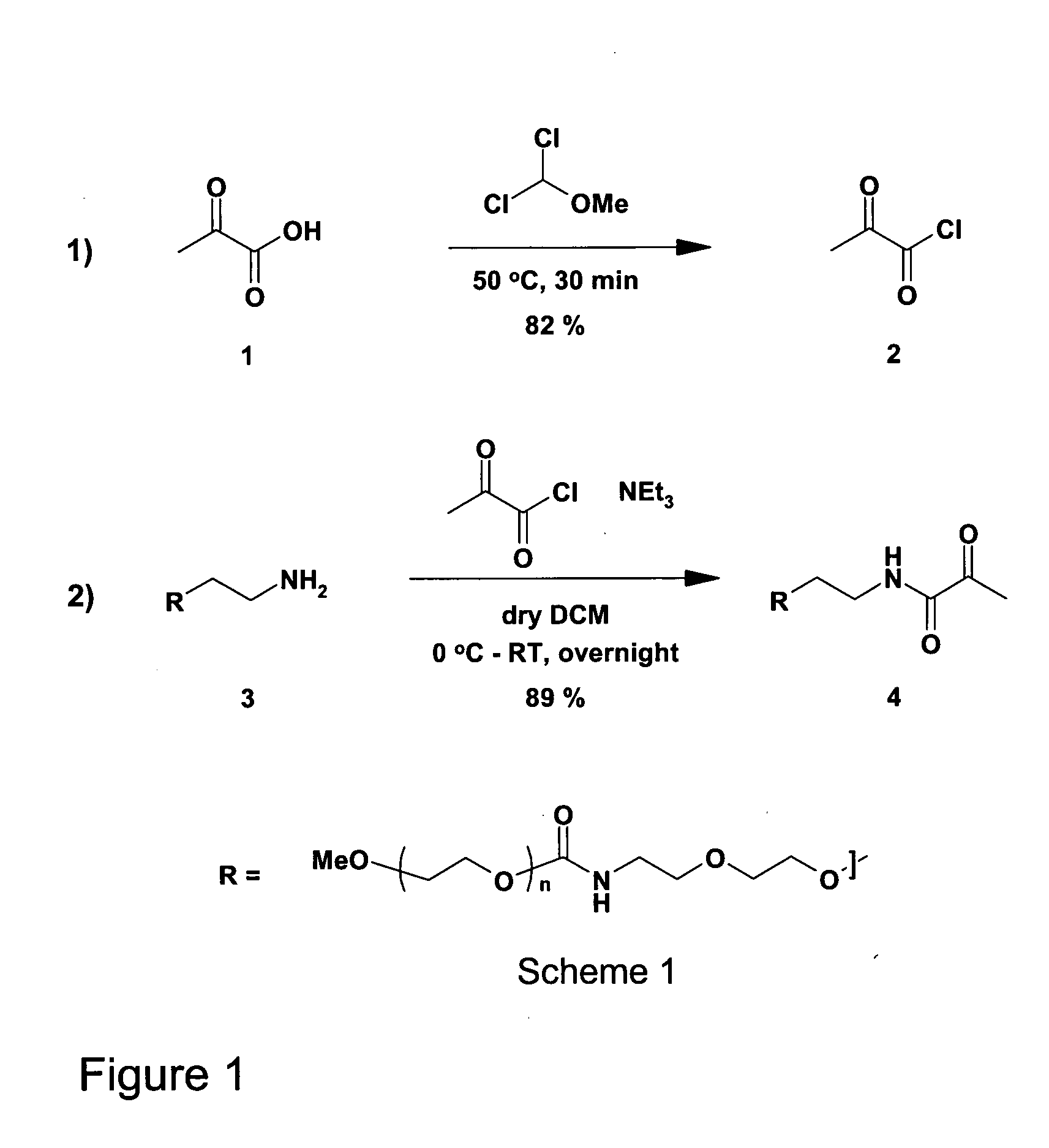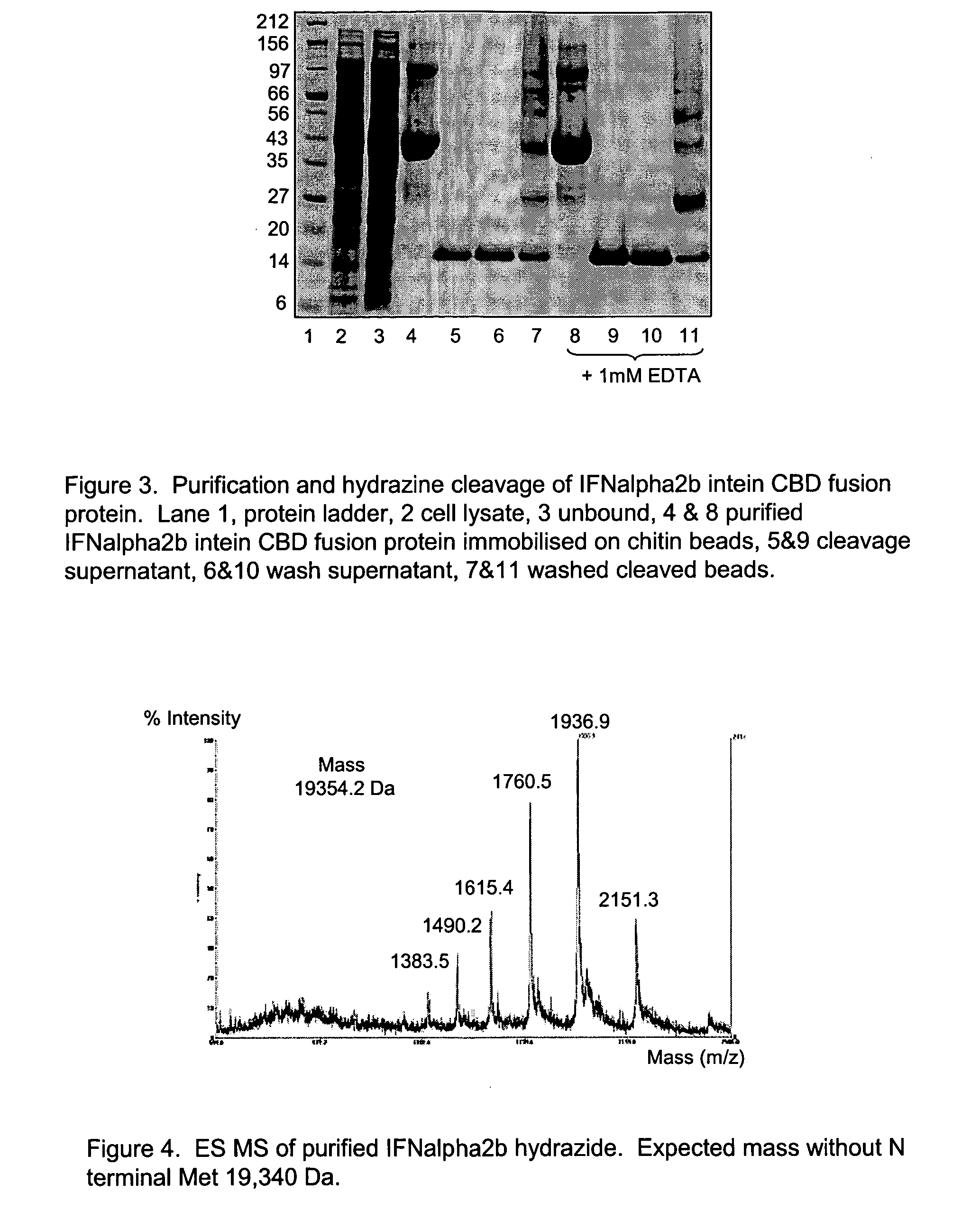Method of labelling interferons with peg
a technology of interferon and labeling method, which is applied in the field of site specific modification of peptides and proteins, can solve the problems of large hydrodynamic radius, limited pharmacokinetics and immunogenicity, and significant increase in the size of the protein to which it is attached, and achieves greater activity and increased protein stability
- Summary
- Abstract
- Description
- Claims
- Application Information
AI Technical Summary
Benefits of technology
Problems solved by technology
Method used
Image
Examples
example 1
Generation of Pyruvoyl-PEG
[0103]A 10 kDa PEG target compound (4), containing an N-terminal pyruvoyl functionality, was prepared as shown in Scheme 1 of FIG. 1. This was achieved by overnight acylation of the commercially available PEG amine (3) with the preformed pyruvoyl chloride (2). The PEG amine was obtained from Nektar {MeO-PEG-NH2Nektar / 2M2U0I01 / PT03F24].
[0104]The acid chloride (2) was formed by treatment of pyruvic acid (1) with α,α-dichloromethyl methyl ether. Briefly, pyruvic acid (5 g) was charged to a 50 ml 3-necked RB flask, under nitrogen, equipped with a reflux condenser, a dropping funnel and connected to a dreschel bottle containing 2N NaOH (aq). α,α-dichloromethyl methylether (5.16 ml) was added dropwise, the reaction mixture was heated to 50° C. for 30 min, the methyl formate byproduct was removed by evaporation under reduced pressure, and the crude acid chloride was obtained as a yellow oil in 82% yield (4.96 g).
[0105]The crude acid chloride was obtained in 82% yi...
example 2
Generation of Site Specifically C Terminal PEGylated IFNalpha2b Hydrazide
example 2.1
Cloning, Expression and Purification of Soluble IFNalpha2B Hydrazide
[0107]IFNalpha2b cDNA (IMAGE clone 30915269) was purchased from Gene Service Ltd. The IFNalpha2b coding sequence was amplified by PCR using the following primers:
[0108]The forward primer was designed to include an NdeI site immediately prior to the 5′ IFNalpha2b sequence:
5′-GGTGGTCATATGTGTGATCTGCCTCAAACCC-3′
[0109]The reverse primer was designed to eliminate the STOP codon at the end of the IFNalpha2b coding sequence, replacing it with a glycine codon followed immediately with a SapI site:
5′-GGTGGTTGCTCTTCCGCACCCTTCCTTACTTCTTAAACTTTCTTGC-3′
[0110]The resulting PCR product was cloned into the NdeI SapI sites of the pTXB1 vector (NEB). This pTXB1 IFNalpha2b GLY construct encodes a fusion protein whereby IFNalpha2b is linked via glycine to the N terminus of GyrA intein that is in turn fused to the N terminus of chitin binding domain (CBD). This was transformed into E. coli Rosetta gami B (DE3) pLysS cells (Novagen) and e...
PUM
| Property | Measurement | Unit |
|---|---|---|
| Fraction | aaaaa | aaaaa |
| Mass | aaaaa | aaaaa |
| Mass | aaaaa | aaaaa |
Abstract
Description
Claims
Application Information
 Login to View More
Login to View More - R&D
- Intellectual Property
- Life Sciences
- Materials
- Tech Scout
- Unparalleled Data Quality
- Higher Quality Content
- 60% Fewer Hallucinations
Browse by: Latest US Patents, China's latest patents, Technical Efficacy Thesaurus, Application Domain, Technology Topic, Popular Technical Reports.
© 2025 PatSnap. All rights reserved.Legal|Privacy policy|Modern Slavery Act Transparency Statement|Sitemap|About US| Contact US: help@patsnap.com



